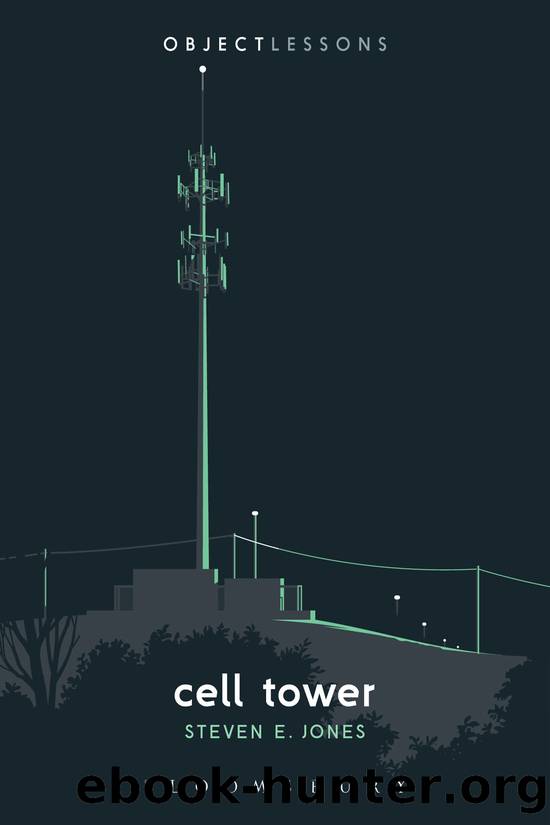Cell Tower by Steven E. Jones;

Author:Steven E. Jones;
Language: eng
Format: epub
ISBN: 9781501348808
Publisher: Bloomsbury USA
FIGURE 9 Speculative cell tower design by Skylar Tibbits for The New York Times Magazine. Illustration courtesy Justin Metz.
Aesthetics aside, Skylar Tibbitsâs design is fundamentally structuralâin fact we might say itâs infrastructural. In the computer or on paper, his tower resembles a 3D wireframe for some more finished object. The design is agnostic when it comes to the actual telecom equipment. Where would antennas be attached? At the top of the morphing towers? They arenât shown in the visualizations, but since his tower is made of cable-like tubes, I suppose that antennas and fiber-optics could conceivably be pulled through them and incorporated into the textile-like structure itself. This is a design fiction, a prototype to think with rather than an actual model to execute. Itâs also an example of materials prototyping. Tibbits is clearly interested in bringing to the surface the underlying properties and behaviors of the materials. He treats cell tower infrastructure as a design problem in its own right.
In this way Tibbitsâs tower recalls aspects of Italian Futurism, an early twentieth-century movement glorifying machinery and materials, celebrating the mechanical, electrical, artificial, and engineered objects of modernity. (Futurists such as Filippo Marinetti, for example, also reveled in violence and war and Futurism had close ties to Italian Fascism.) Milan architect Antonio SantâElia published a Futurist Manifesto in 1914 that proclaimed in its first two points:
1.âThat Futurist architecture is the architecture of calculation, of audacious temerity and of simplicity; the architecture of reinforced concrete, of steel, glass, cardboard, textile fiber, and of all those substitutes for wood, stone and brick that enable us to obtain maximum elasticity and lightness;
2. That Futurist architecture is not because of this an arid combination of practicality and usefulness, but remains art, i.e. synthesis and expression[.]15
Key terms in point 1 (textile fiber, maximum elasticity, and lightness) could describe whatâs most important about the MIT cell tower. The morphing-mesh of the tower also owes something to a late twentieth-century style called blobitecture (from blob-architecture), identified with the work of Greg Lynn and Frank Gehry in particular.16 Like objects designed in the Self-Assembly Lab, and ultimately in the spirit of calculation celebrated in the Manifesto of Futurist Architecture, blob-buildings and blobjects are highly dependent on computers and software to produce their complex biomorphic shapes. All of these approaches have in common an interest in the design of infrastructure itself, a kind of materials engineering as design. To think of cell towers as designable, in a way that would foreground their materials as well as their essential functions, might be one way to begin to co me to grips with their increasing role in our everyday lives. It might help us to get a better sense of how much our handheld devices really require in the way of supporting infrastructure, to better understand how much their magic costs.
Tall towers in the background may eventually be replaced with many small antenna-boxes everywhere, if true 5G systems succeed the current 4G LTE standard.17 In a kind of circular logic, the
Download
This site does not store any files on its server. We only index and link to content provided by other sites. Please contact the content providers to delete copyright contents if any and email us, we'll remove relevant links or contents immediately.
Twisted Games: A Forbidden Royal Bodyguard Romance by Ana Huang(2523)
The Push by Ashley Audrain(2252)
Den of Vipers by K.A Knight(2179)
Win by Harlan Coben(2052)
Echo by Seven Rue(1875)
Leave the World Behind by Rumaan Alam(1709)
Beautiful World, Where Are You: A Novel by Sally Rooney(1614)
Midnight Mass by Sierra Simone(1575)
Iron Widow by Xiran Jay Zhao(1471)
The Four Winds by Hannah Kristin(1457)
Baby Bird by Seven Rue(1415)
The Warrior's Princess Prize by Carol Townend(1402)
Undercover Threat by Sharon Dunn(1401)
Bridgertons 2.5: The Viscount Who Loved Me [Epilogue] by Julia Quinn(1393)
Sister Fidelma 07 - The Monk Who Vanished by Peter Tremayne(1340)
Snowflakes by Ruth Ware(1233)
Vanessa Yu's Magical Paris Tea Shop by Roselle Lim(1215)
The Golden Cage by Camilla Lackberg(1185)
The Midwife Murders by James Patterson(1147)
